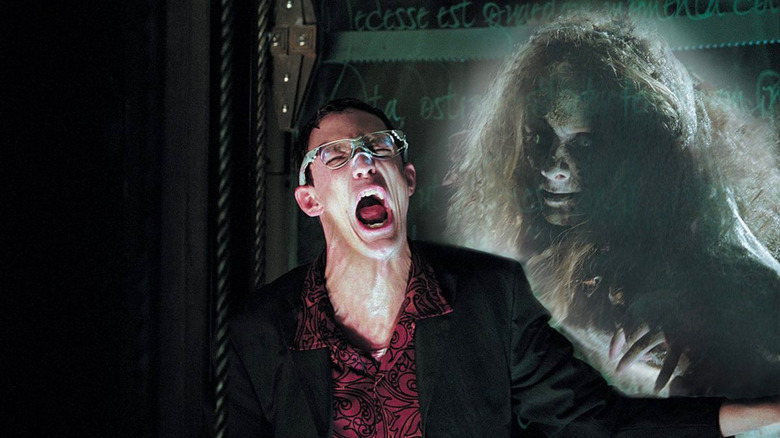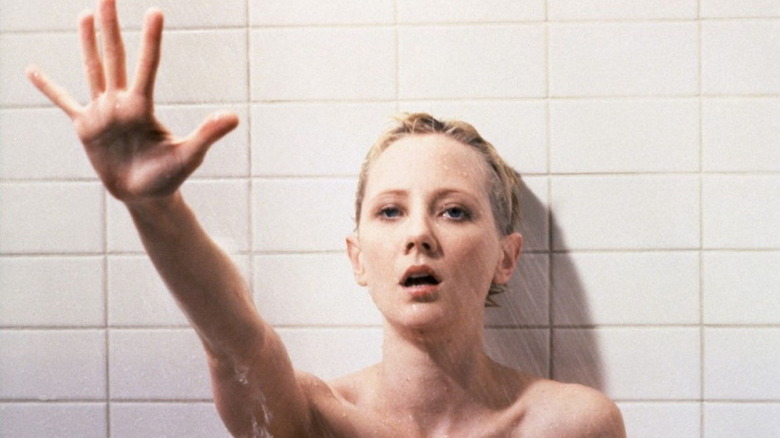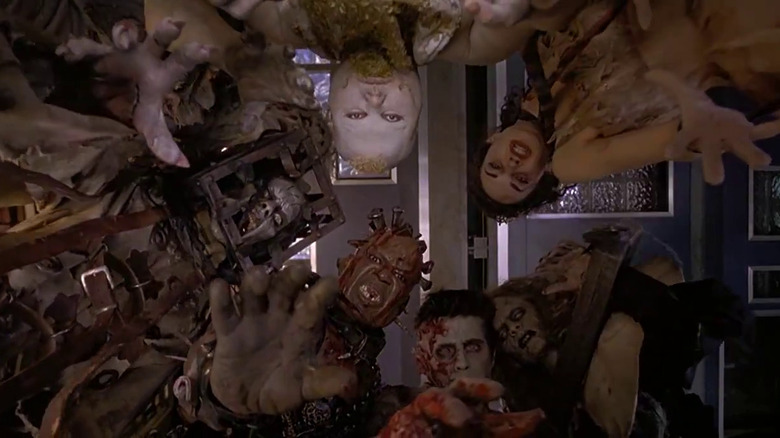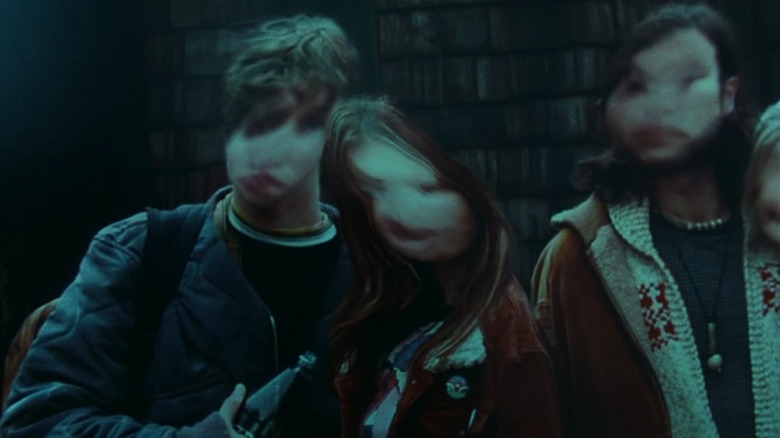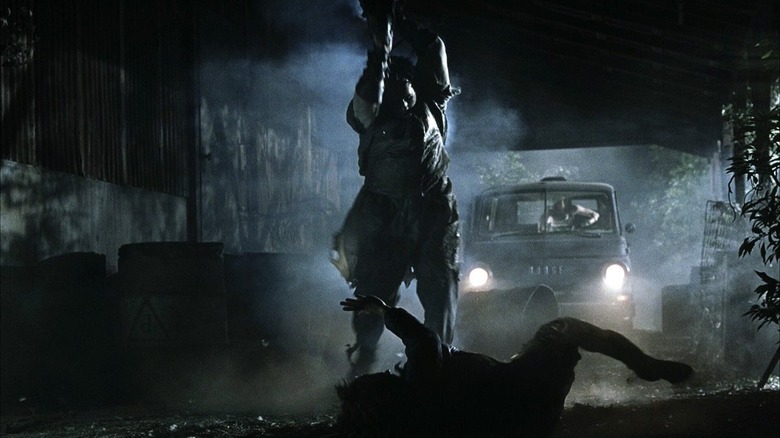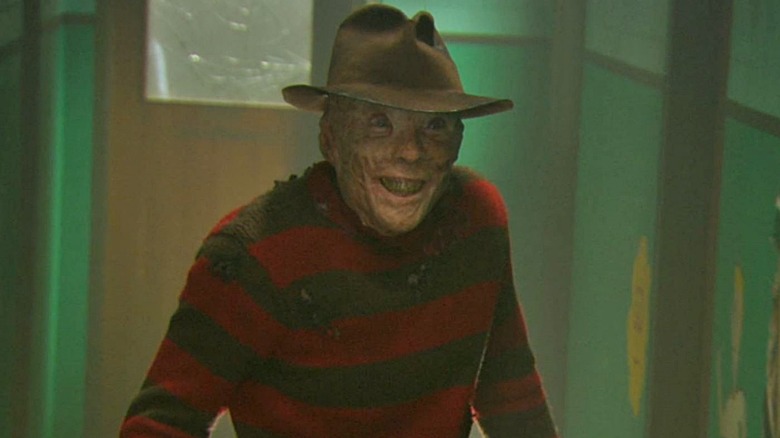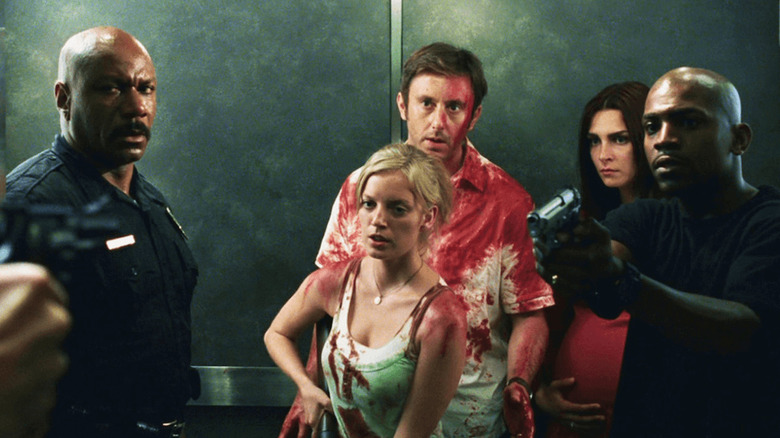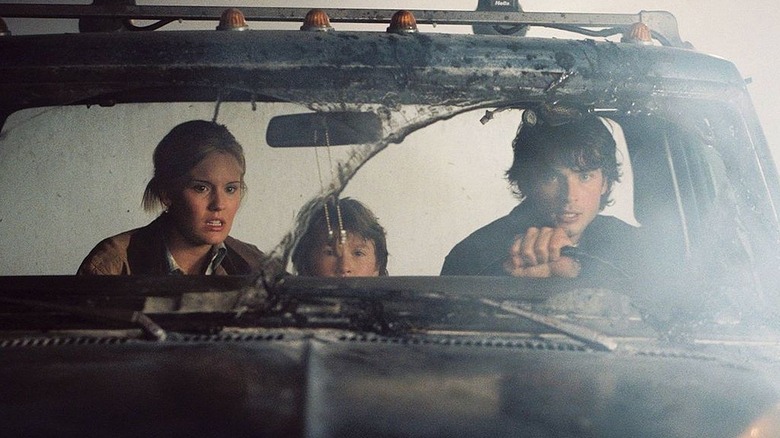The Early 2000s Remake Boom Was A Low Point For The Horror Genre (With A Few Notable Exceptions)
Remakes are as old as the movies themselves, and despite a certain stigma, there's nothing wrong with a remake. In fact, on several notable occasions, remakes can be just as good — if not better — than their forbearers. Horror remakes, in particular, can yield great results — David Cronenberg's remake of "The Fly" and John Carpenter's remake of "The Thing" are both considered some of the best horror movies of all time. But in the early 2000s, studios got horror-remake-happy, and the fruits of these efforts were also quite rotten. More often than not, the horror remake boom of the early 2000s yielded watered-down, lackluster imitations of what had come before.
But not always. Sometimes, an inspired filmmaker comes along and works magic. What makes a good horror remake? That feels like an almost impossible question to answer, and I want to paraphrase United States Supreme Court Justice Potter Stewart by shrugging the whole thing off by saying "I know it when I see it." But that's a cop-out. I don't think there are any criteria for making a horror remake "good." It's all a question of the material, and how it's approached. Can you give us something new? Can you give us something familiar that feels new? Can you take the ideas conjured up by the original and take them in a new direction? These are questions that must be asked of remakes, but they're not rules set in stone like names and dates chiseled into grave markers.
Besides, the question of what makes a good horror remake isn't as easy to answer as what makes a bad horror remake. To pull that off, filmmakers get lazy, get cheap, or miss the point entirely. Such was the case in the early 2000s when producers saw dollar signs in their eyes and plowed forward, hoping no one would notice the gray gruel they were being spoonfed. And yet, every now and then, something genuinely good would escape through the cogs of the movie-making machine. The early 2000s weren't a complete bust for horror — but it wasn't an era of smashing successes, either.
We all go a little mad sometimes
The era of endless horror remakes didn't quite begin in the 2000s — the late '90s gave it a leg-up. After earning a slew of Oscar nominations for "Good Will Hunting," indie auteur Gus Van Sant decided to parlay his new-found clout to try something unique: a shot-by-shot remake of Alfred Hitchcock's "Psycho." It felt like a crazy thing to do — remaking Hitchcock often does. "Psycho" is an undeniably iconic film — who was Van Sant to think he had anything new to bring to the table? The argument could've been made that he didn't, since his remake set out to recreate the original beat-for-beat.
And yet, despite lackluster reviews and box office, Van Sant's "Psycho" is fascinating. It's not so much a movie as it is an art experiment that Van Sant was able to have distributed by a major studio. Yes, Van Sant and cinematographer Christopher Doyle recreate Hitchcock's shots. But the new cast, coupled with color film (featuring some highly memorable lighting, bright and disorienting with just a touch of haze) creates a new experience. It's not as good as what Hitchcock did, but it's interesting, damn it!
A year later, the early hints of the remake trend continued with "House on Haunted Hill," a delightfully zany take on the 1959 William Castle film. Released right around Halloween, "House on Haunted Hill," which followed a group of strangers trapped in a sprawling, abandoned, and haunted mental asylum, felt like the perfect Halloween party rolled into a movie. Shot on a low budget, the film was a box office hit (taking in $43 million on a $19 million budget), and sent a message that audiences would flock to horror remakes under the right conditions. Which meant more remakes were on the way, gathering on the edge of darkness, waiting to swoop in to terrify — or disappoint — audiences.
Bathrooms! Everyone gets their own bathroom!
Released in October of 2001, weeks before the September 11 attacks would change the world — and movie landscape — forever, Dark Castle Entertainment, the folks behind the "Haunted Hill" remake, released another William Castle-inspired remake. This was "Thirteen Ghosts," which took the 3D fun of the 1960 original and twisted it into a cacophonous mess that made me want to rip my own ears off. Painfully unfunny and featuring a grating, extremely over-the-top turn from Matthew Lillard as a stressed-out psychic, "Thirteen Ghosts" finds a family moving into a huge modernist home, willed to them by an estranged dead relative. Sure enough, the house is haunted by a baker's dozen worth of ghosts, all of whom appear in annoying flashes.
The maddening thing about "Thirteen Ghosts" is that you can sort of see the better movie buried under the junk. The cast (including a sympathetic Tony Shalhoub) is game, and the makeup effects are phenomenal — even though we never get a good look at them thanks to the cruddy editing. But "Thirteen Ghost" is too irritating for its own good and features baffling scenes, like when Shannon Elizabeth, playing Shalhoub's daughter, spends what feels like 10 minutes obsessing over the house's bathroom.
A box office dud, "Thirteen Ghosts" could've signaled the beginning of the end for the horror remake era. But it was just getting started.
Before you die you see the ring
In the wake of 9/11, horror movies would enter a torture porn era, often cited as a direct result of the so-called War on Terror — films like "Saw" and "Hostel." But the remake crazy began to really boom in 2002 when DreamWorks released Gore Verbinski's "The Ring." Based on the 1998 Japanese film "Ringu," "The Ring" is a moody, creepy, incredibly slick horror production tailor-made to send chills down your spine. In some cases, it's even better than the original, as it constructs a tighter narrative to go along with its scares.
Intrepid reporter Naomi Watts starts looking into the untimely death of her niece, only to discover a cursed videotape that kills everyone who watches it. At the time of release, VHS was already on the way out, which made the haunted videotape angle even creepier — analog things are always spookier than new tech, right? We can all agree on that. Nothing creepy about surfing a laptop. But firing up a microfilm machine? That's the creepy sweet spot, oh yeah.
"The Ring" was a massive success, hauling in $249.3 million and scaring audiences everywhere. It triggered a trend of J-horror (and Asian-inspired horror in general) remakes, none of which could ever match the success of "The Ring." "The Grudge," released in 2004, comes somewhat close, but the original film is superior, and all the remake's best scares come directly from the original, which makes the entire thing quite unoriginal. The U.S. would also remake titles like "One Missed Call," "Dark Water," and "Pulse," the latter of which being the worst offender — a film that took one of the scariest movies ever made (Kiyoshi Kurosawa's "Kairo") and molded it into unscary, uninteresting crap plagued by unhelpful reshoots. But while the J-horror subgenre would see its own continuation, more domestic-inspired remakes were still on the way.
The saw is family
Founded in 2001 by Michael Bay, Brad Fuller, and Andrew Form, the production company Platinum Dunes would be one of the major contributors to the horror remake boom. It started in 2004, with "The Texas Chainsaw Massacre." A remake of Tobe Hooper's seminal "The Texas Chain Saw Massacre," "Texas Chainsaw" was the first of the horror remakes from the era that garnered considerable controversy before release. The film was arriving when the internet was becoming ubiquitous to everyday life, and angry nerds were taking to movie message boards and blogs to complain about, well, everything.
People were not happy that someone was daring to touch Hooper's classic, and you can't blame them. Grungy, bleak, and possessed with a crazed, outsider art spirit, the original "Texas Chain Saw Massacre" is unparalleled. What could someone possibly offer by remaking it? Reviews were considerably mixed, and yet, I think the 2004 remake is surprisingly good. Is it anywhere near the original? Oh, f*** no. But director Marcus Nispel brings shocking brutality to the film. It never feels dangerous like the original film, but this is bleak, nasty stuff for a mainstream picture. The plot is essentially the same: a group of youths runs afoul of a cannibal family. But Nispel's blend of blood and heightened style conjures up a feeling of unease and terror that lingers long after the credits roll.
As for the rest of the Platinum Dunes remake output? Well ... it was pretty much all downhill from there.
The duds of Platinum Dunes
The 2005 "The Amityville Horror" remake is probably better known today for introducing the world to Ryan Reynolds' newly-formed cut-from-granite abs than anything else. It's a lot snappier than the admittedly dry original, but it's also full of the type of cheapo jump scares that add up to nothing. In 2007, Platinum Dunes went even lower with their forgettable remake of "The Hitcher." (Seriously: when was the last time anyone mentioned "The Hitcher" remake?) Based on Robert Harmon's cult classic, "The Hitcher" remake makes the inspired decision to cast Sean Bean as the malevolent title character, but every choice comes up short. The remake abandons the original's homoerotic undertones for a more straightforward slasher action pic that never pays off. It has to be one of the most forgettable movies of all time. You probably already forget it exists.
In 2009 and 2010, Platinum Dunes decided to go big or go home. "Amityville" and "The Hitcher" were inspired by films held near and dear to horror fans, but now it was time for Platinum Dunes to bring back iconic slashers Jason Voorhees and Freddy Kruger. The 2009 "Friday the 13th" remake, helmed by "Texas Chainsaw" director Marcus Nispel, has its fans — but I'm not one of them. Aside from a killer prologue, "Friday the 13th" drags, and drags, and drags. It also tries to compact the various tones of the original franchise's many sequels into one movie, creating an overall schizophrenic experience. The Platinum Dunes remake of "A Nightmare on Elm Street" faired even worse. Jackie Earle Haley is a good idea, in theory, to play Freddy Krueger. But the actor is given almost nothing to work with here, and he doesn't get much help — the usually acclaimed Rooney Mara gives arguably the worst performance of her career as final girl Nancy.
Whatever you think of these films, it's telling that neither spawned a sequel (although to be fair, "Friday the 13th" is tied up in legal woes). They came and then they went away quietly.
No more room in hell
By 2004, internet grumbling had grown even more prominent in our society. Which meant that Zack Snyder's "Dawn of the Dead" remake was going to face an uphill battle. How dare anyone try to remake the work of Saint George A. Romero? On top of that, I remember people being outraged that the script was from James Gunn, who at the time was primarily known as the guy who wrote the live-action "Scooby-Doo" movie. And just to add insult to injury, Snyder's zombies would run, throwing off the mindless shuffling of Romero's undead.
But a curious thing happened — Snyder's remake ended up being a lot of fun. It doesn't even come close to matching the iconography of Romero's original, nor the biting satire that makes that film so notable. Indeed, Snyder doesn't care about any of that — he wants to make something cool. And his "Dawn of the Dead" is indeed cool — full of big action, over-the-top bloody attacks, and an opening sequence that kicks ass. No one will ever accuse it of being as good as Romero's film, and indeed, Romero spent the post-release years of the remake at horror conventions selling t-shirts emblazoned with phrases like "FAST ZOMBIES SUCK." But there's a panache to Snyder's film that I appreciate.
And "Dawn of the Dead" wouldn't be the last time someone would remake Romero in this era. In 2010, when the remake boom was nearing its end, audiences were treated to "The Crazies," a story of a town gone insane. And you know what? Like "Dawn of the Dead," it was pretty damn good, while also not coming close to the original.
The end of an era
After 2005, the horror remake boom began to decline, especially in terms of quality. In 2005, a remake of John Carpenter's "The Fog" drifted into theaters, with abominable results. Carpenter's original is a classy, slow-burning ghost story, whereas the remake is a lifeless, soulless husk; a skeleton stripped of its skin and muscles, down to its bare, boring bones. In 2006, to coincide with the fact that we were going to have a date that read 6/6/06 (ya know, like the mark of the beast!), 20th Century Fox released a remake of "The Omen." Like Gus Van Sant's "Psycho," it's almost a carbon copy of the original. But it lacks the special something Van Sant brought to the Bates Motel, and is inherently forgettable as a result. That same year saw the release of a remake of "Black Christmas," and while that film gets points for its splatter-pic-worthy gore, it's big, loud, and stupid — three things that can't be said about Bob Clark's slow-burning original holiday chiller.
But there were still diamonds glittering in this pile of s***. Jaume Collet-Serra's downright zany "House of Wax" remake — which feels more like a remake of late '70s slasher "Tourist Trap" than it does the Vincent Price film it takes its name from — gets by on extreme style, and concludes with the blasting music of My Chemical Romance. It rules. Then there was Alexandre Aja's relentlessly violent remake of Wes Craven's "The Hills Have Eyes," a film about forgotten Americans coming out of the desert, deformed and ready to kill anyone and everyone.
Another Wes Craven remake, 2009's "The Last House on the Left," ended up being better than anyone expected — although there was some resentment that the movie was entering torture porn territory (not that Craven's original was some chaste, bloodless experience). That same year also gave us a surprisingly fun — and seemingly forgotten — remake of "The House on Sorority Row," titled simply "Sorority Row" (and featuring a highly-memorable kill involving a bottle of booze).
But the clock was ticking. A year later gave us remakes of "I Spit on Your Grave" and "Mother's Day." A year after that brought on a remake of John Carpenter's "The Thing." But the bubble had burst. Horror remakes would continue — indeed, they'll never die. But the seemingly endless glut of titles that flooded in during the early 2000s finally dried up. And now we're left with an odd legacy — a mix of surprisingly good movies nestled among a landscape of steaming crap. And the thing is: Hollywood is cyclical — it loves to repeat itself. Which means it's only a matter of time before a new wave of questionable remakes starts rising from the grave. Talk about scary.
